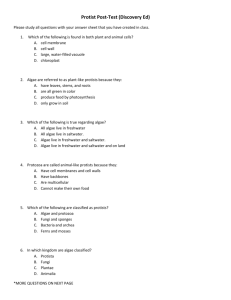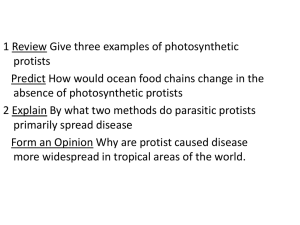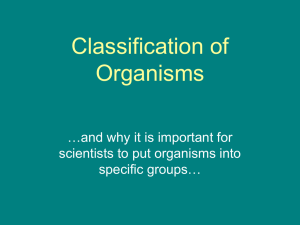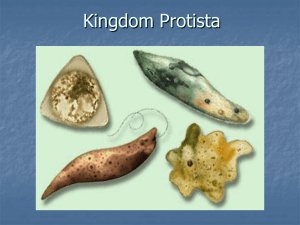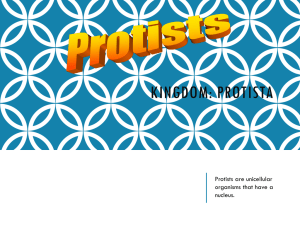Protists Notes
advertisement
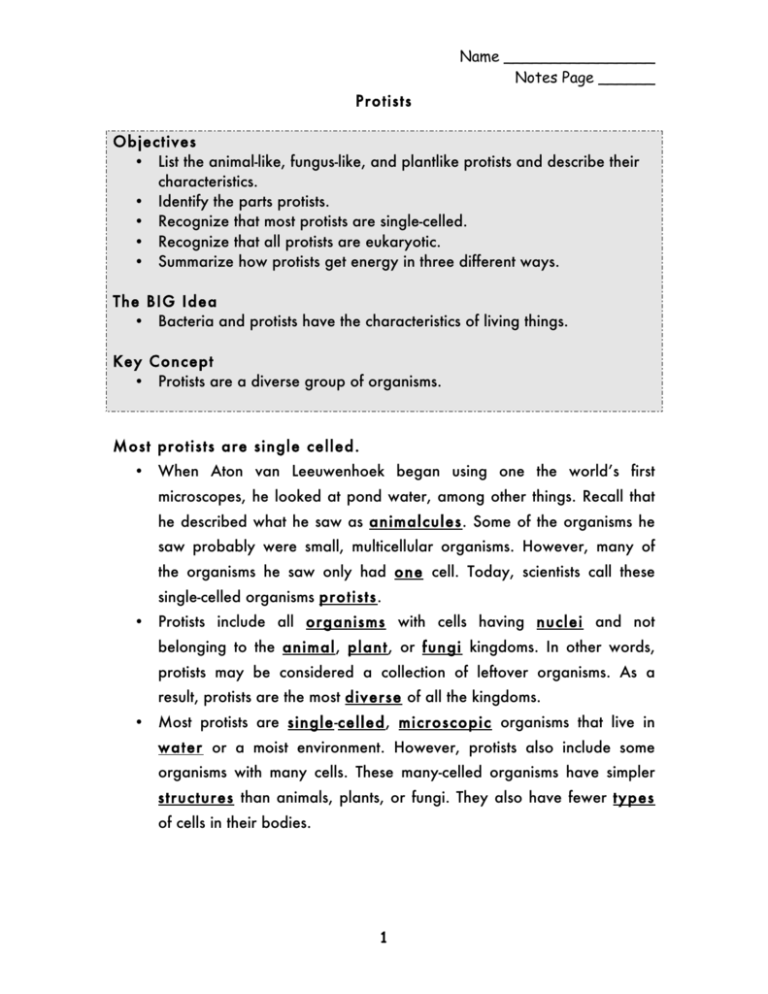
Name ________________ Notes Page ______ Protists Objectives • List the animal-like, fungus-like, and plantlike protists and describe their characteristics. • Identify the parts protists. • Recognize that most protists are single-celled. • Recognize that all protists are eukaryotic. • Summarize how protists get energy in three different ways. The BIG Idea • Bacteria and protists have the characteristics of living things. Key Concept • Protists are a diverse group of organisms. Most protists are single celled. • When Aton van Leeuwenhoek began using one the world’s first microscopes, he looked at pond water, among other things. Recall that he described what he saw as animalcules. Some of the organisms he saw probably were small, multicellular organisms. However, many of the organisms he saw only had one cell. Today, scientists call these single-celled organisms protists. • Protists include all organisms with cells having nuclei and not belonging to the animal, plant, or fungi kingdoms. In other words, protists may be considered a collection of leftover organisms. As a result, protists are the most diverse of all the kingdoms. • Most protists are single-celled, microscopic organisms that live in water or a moist environment. However, protists also include some organisms with many cells. These many-celled organisms have simpler structures than animals, plants, or fungi. They also have fewer types of cells in their bodies. 1 There are three groups of protists. • When we examine protists, we see that they share many characteristics. Scientists are able to group the protists based on how they obtain their energy. They name each group of protists based on the kingdom they most resemble. • The three groups of protists include animal-like, plant-like, and funguslike. What are protists? Single or multi-celled organisms that have nuclei but do not fit in the other kingdoms. Where do most protists live? In water or moist environments. Why is the protists kingdom considered the most diverse? It includes all organisms that do not fit into any of the other categories. It is the “leftover” kingdom. There are four types of animal-like protists. • Protists that eat other organisms, or decaying parts of other organisms, are animal-like protists, called protozoa. • They include many forms, but they are all unicellular. Protozoa cannot use sunlight as a source of energy. Therefore they are heterotrophs. Also, protozoa must move to obtain their energy. • Certain chemicals in protozoa can recognize when a particle of food is nearby. The food particle is usually another organism or part of one. The protozoan ingests the good and breaks it down to obtain energy. • There are four types of animal-like protists. They are classified by how they live and move. • The first is protozoa with pseudopods. o This group of protozoa use pseudopods to move. Pseudopods are temporary bulges of the cell membrane that fill with cytoplasm. 2 o When the cell fills the pseudopod with cytoplasm, the rest of the cell follows, causing it to move in that direction. o Pseudopods are use primarily for two reasons: to move and to capture food. o This group of protozoa are called sarcodines. An example of this group is the amoeba. • The second is protozoa with cilia. o These protozoa are called ciliates because they have a structure called cilia. o Cilia are hair-like projections from the cell that move in a wavelike pattern. Ciliates use cilia to move, obtain food, and to sense the environment. o Ciliates have very complex cells. This is because they have two nuclei. The large nucleus controls the everyday tasks of the cell. The small nucleus functions in reproduction. Ciliates can reproduce through binary fission but also use conjugation. o A common example of ciliates include paramecium, one of the most well-known protists. • The third group is protozoa with flagella. o This group of protozoa is called zooflagellate. These organisms use their flagella to move. Zooflagellates can have one to eight long, whip-like flagella to help them move. o Many zooflagellates live in organisms. More often than not, these organisms benefit each other. This is an example of symbiosis. o However, not all symbiotic relationships are good. For example, malaria is a disease that is caused by protists. • The fourth group of protozoa is diverse. o This group of protozoa moves in a variety of ways. However, they are grouped on how they live. o For example one group is the sporozoans, which feed on their host’s cells and body fluids. 3 What is the name given to all animal-like protists? Protozoa Identify the name of the group of protozoa that have the following characteristic. Has flagella: zooflagellates Has cilia: ciliates Feeds on cells: sporozoans Has pseudopods: sarcodines Why are sporozoans not classified by how they move? They move in a variety of ways. Therefore, they are classified by how they live. There are six types of plant-like protists. • Plantlike protists, called algae, obtain their energy from sunlight. Like plants, algae use the Sun’s energy, water, and carbon dioxide from the air or water to produce food. Algae contain chlorophyll (and chloroplasts). Because they produce their own food, all algae are autotrophs. • Algae include organisms that are unicellular, unicellular but live in colonies, and multicellular. If the cells form a colony, certain cells can carry out specific functions: reproduction, capturing food, etc. • Algae also come in a variety of colors, even if their cells contain chloroplasts and chlorophyll. This is a result of the cells having pigments. • Euglenoids o Euglenoids are green, unicellular algae that found mostly in fresh water. o Although they are classified as plant-like protists, they have an unusual characteristic. Given the right circumstances, these algae can be heterotrophs. This will occur when there is not enough sunlight. 4 o Euglena, a common euglenoid, is able to detect light through the use of its eyespot. Should you place them in a container and expose half in sunlight, all of the euglena will move to the sunlit side. • Dinoflagellates o Dinoflagellates are like the knights of the protist kingdom. Stiff plates of silica, that look like armor, cover their body. o You will most commonly find these in saltwater environments. o All dinoflagellates are unicellular. To move, they have two flagella that cause them to twirl. • Diatoms o Diatoms are unicellular and have glasslike cell walls. Some simply float on the surface of the water. If any organism (including plants, animals, and protists) drifts in water they are called plankton. If they are able to carry out photosynthesis, they are called phytoplankton. o Sometimes diatoms will attach themselves to a surface. o Diatoms have a unique way to move: they shoot chemicals from their cell wall. It’s similar to jet propulsion. o When they die, their cell walls collect at the bottom of sea floors. As a result, they form a material called diatomaceous earth. This substance is often found in toothpaste. It does a great job at polishing your teeth. • Green, Red, and Brown Algae o This group of protists is what you think of when you hear the word seaweed. There are many different organisms that are classified under green, red, and brown algae. o The major difference between these types of algae is there color and where they live. o Green algae can be found in both fresh and saltwater. Some can be found on land but it must be in moist environments. It can also be unicellular or multicellular. 5 o Red algae are mostly multicellular seaweeds. Their red color helps them absorb light deep in the ocean. This means they can grow deeper in the ocean where there is less competition from other organisms. o Brown algae are what most people refer to when they encounter seaweed. Even though they are brown, they have a variety of pigments. These also make the giant kelp forests in the Pacific costal waters. Of the plant-like protists, which can be a heterotroph? Euglenoid Which group is unicellular? Dinoflagellates What causes plant-like protists to have such a variety of colors, even though they have chloroplasts? Pigments How do protozoa and algae differ in the way they get their energy? Protozoa eat other organisms and get energy from the nutrients in the organisms they eat. Algae get energy from sunlight. There are three types of fungus-like protists. • Protists that absorb food from their environment can be called fungus-like protists. These protists take in materials from the soil or from other organisms and break materials down in order to obtain energy. They are called decomposers. • The term “mold” refers to many organisms that produce a fuzzy-looking growth. Most of the molds you might be familiar with, like bread mold, are fungi (not protists). But three groups of protists are also called molds. • These molds have structures that are too simple to be called fungi, and they are unicellular for a portion of their lives. • 6 • Water molds o One example of a fungus-like protist is water mold, which forms a fuzzy growth on food. This food may be decaying animal or plant tissue or a living organism. Water molds live mainly in fresh water. • Slime molds o Slime molds live on decaying plants on the forest floor. One kind of slime mold consists of microscopic single cells that ooze around, eating bacteria. o When their food is scarce, however, many of the cells group together to produce a multicellular colony. The colony eventually produces a reproductive structure to release spores. o Wind can carry sports about, and they sprout where they land. • Plasmodial slime molds o You might see this type of mold while walking through a forest. The organism looks like a fine net, like lace, several centimeters across, on rotting logs. o These slime molds are not multicellular, but instead one giant cell with many nuclei. They form when many different cells fuse together to form one large cell. Compare and contrast slime molds and plasmodial slime molds. Both slime molds and PSMs are unicellular. PSMs have many nuclei in one cell. They form when many different cells fuse together. Slime molds can form colonies to reproduce. 7




